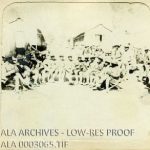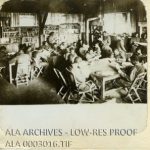In honor of Black History Month and the 100th anniversary of the United States’ entry into World War I, it is only fitting to discuss the service of African Americans in the war and to highlight a few materials we have here at the archives that illustrate their contributions.
In 1917, Congress passed the Selective Service Act, which Woodrow Wilson then signed into law, thus initiating the draft. It required all young men, regardless of race, to register for service [1]. Subsequently, more than 2.2 million black men registered over the course of four draft calls [2], of which nearly 370,000 were then inducted into the Army [3].
W.E.B. Du Bois was one of many African American leaders and activists who saw the war as a chance to advance racial progress, hoping that racial equality would follow at the war’s end when Americans saw their loyalty and service to their country. He urged black men to put the fight for civil rights on hold during the war, writing in The Crisis, “first your Country, then your Rights!” [4].
Of the African American men who were drafted, 89 percent served in labor battalions or as dockworkers. The 42,000 men who did serve in combat were limited to the only two all-black combat regiments, the Ninety-Second and Ninety-Third Divisions [5]. The camps were also segregated, as were most of the YMCA “Y-huts,” which served as places for leisure activities and often had camp libraries, stocked with the help of the ALA’s Library War Service [6]. (For more information about the Library War Service, please see our research guide.)
A valuable record series here at the archives containing WWI material is 89/1/5 (War Service Correspondence, 1917-1923). A report in Volume 31 provides a list of camps and places where library services were provided in France, and many of the huts and clubs distinguish whether they were for white or black soldiers [7]. The YMCA huts provided educational programs that were particularly valuable for African American troops who had higher rates of illiteracy, reportedly as high as 80% in some camps [8]. Volume I, Issue 3 (1918) of War Libraries, a newsletter of the ALA War Service Committee, draws attention to the fact that 12,000 “stevedores” (dockworkers) near the ports where U.S. transport ships and supplies landed in France had their first chance to learn to read through the efforts of the Library War Service and others [9].
The archives also has record that the Library War Service provided 1,000 volumes to the Columbus Avenue Rest Camp for Soldiers in Boston. The house was opened and furnished in 1918 with money raised by more than 300 African American women who formed “Mrs. Butler R. Wilson Knitting Classes.” In further efforts to support soldiers, these women sent their completed knitting projects (500 sweaters, 500 pairs of socks, 150 “trench caps,” and 150 “wristers”) to black soldiers and sailors both in the training camps and at the front, in addition to raising $4,845 to send to black troops at Camp Upton [10].
Record series 89/1/5 (War Service Correspondence, 1917-1923) also includes letters from Mr. Edward K. Nichols, Secretary of the War Camp Community Service Colored Soldiers’ Club in Atlanta, Georgia and then Columbus, Georgia after he was was reassigned. He wrote to Henry O. Severance of the American Library Association to ask for books on behalf of the soldiers club of Camp Gordon and then the club at Fort McPherson. These letters provide insight not only into the work of the Library War Service, but also a much larger component of black history in the South. On August 15, 1919 he wrote,
“You are doubtless aware that throughout the South the public libraries are closed to the colored people. Hence every organization having in its power to extend library facilities to the colored people at large or any group of them has the opportunity of rendering a very needed and much appreciated service” [11].
In a subsequent letter on August 26, 1919, he indicates that the books for the club would not only benefit the soldiers, but also “a large percentage of the professional people and teachers of the city” [12]. There are portions of the letter that are emotional and difficult to read now in the year 2017. He wrote,
“Again allow me to suggest that in the matter of reading our people have the same tastes as those of other races, varying according to degrees in culture, and that almost all degrees of culture are represented in every large group of our people in almost every community. And further, unless we are afforded opportunities for satisfying our craving for these higher things through such agencies as yours, we shall have to go without” [13].
These narratives, though painful to come across, are nevertheless crucial to understanding the experiences of African American men and women during WWI. Ultimately, their service failed to usher in the racial equality for which so many had been hoping and fighting. Race riots swept the country in the summer following the end of the war, earning the nickname, the “Red Summer” [14]. Lynchings increased, and discrimination, segregation, and racial violence continued. Yet among many, the resolve to fight racism and oppression was strengthened by their war experience. In 1919, Du Bois wrote, “we Soldiers of Democracy…return from fighting. We return fighting” [15].
[1] Nina Mjaghij, Loyalty in Time of Trial: The African American Experience during World War I (New York: Rowman & Littlefield Publishers, Inc., 2011), xx.
[2] Ibid., 74.
[3] Ibid., xx.
[4] Ibid., xxii.
[5] Ibid., 73.
[6] Ibid., 93.
[7] “The American Library Association in Base Section No. 1, France,” c. 1919, War Service Correspondence, 1917-1923, Record Series 89/1/5, Box 6, Volume 31, p. 559, American Library Association Archives at the University of Illinois at Urbana-Champaign.
[8] Mjaghij, Loyalty in Time of Trial: The African American Experience during World War I, 94.
[9] “The A.L.A. Follows the Flag Overseas,” War Libraries, Vol. 1 Num. 3 (September 19, 1918), p. 6, War Libraries and War Library Service Bulletins, 1917-1919, Record Series 89/1/10, Box 1, Folder: War Libraries, 1918, American Library Association Archives at the University of Illinois at Urbana-Champaign.
[10] “Wonderful War Work by Women: Achievements among the Colored People of Boston,” c. 1918, War Service Correspondence, 1917-1923, Record Series 89/1/5, Box 6, Volume 30, p. 34-36, American Library Association Archives at the University of Illinois at Urbana-Champaign.
[11] Edward K. Nichols to Mr. H. O. Severance, August 15, 1919, War Service Correspondence, 1917-1923, Record Series 89/1/5, Box 3, Volume 19, p. 484, American Library Association Archives at the University of Illinois at Urbana-Champaign.
[12] Edward K. Nichols to Mr. H. O. Severance, August 26, 1919, War Service Correspondence, 1917-1923, Record Series 89/1/5, Box 3, Volume 19, p. 489, American Library Association Archives at the University of Illinois at Urbana-Champaign.
[13] Ibid.
[14] Mjaghij, Loyalty in Time of Trial: The African American Experience during World War I, 114.
[15] Ibid., 146.






